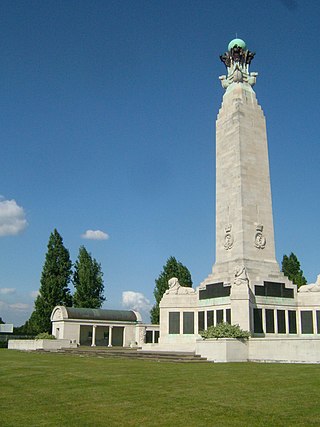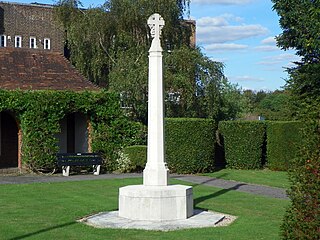
Chatham Naval Memorial is a large obelisk situated in the town of Chatham, Kent, which is in the Medway Towns. The memorial is a feature of the Great Lines Heritage Park. The huge expanse of the Great Lines was in its own right a layer of defence to protect Chatham Dockyard from attack.

The Royal Fusiliers War Memorial is a memorial in London, dedicated to the members of the Royal Fusiliers killed in the World Wars, Russian Civil War and subsequent conflicts, along with members of a number of London Regiment battalions killed in the First World War. It consists of a bronze statue on a 16.5 feet (5.0 m) pedestal made of Portland stone.

St Mary's Church is in North Drive, Wavertree, Liverpool, Merseyside, England. It is an active Anglican parish church in the deanery of Toxteth and Wavertree, the archdeaconry of Liverpool, and the diocese of Liverpool. The church is recorded in the National Heritage List for England as a designated Grade II listed building.

The Boer War Memorial, also known as the South African War Memorial, stands in a prominent position in Queens Park, Crewe, England. It was erected in memory of local soldiers who had served or fallen in the Boer War, and consists of a bronze statue of soldier in uniform standing on a column on a stone plinth. The monument was unveiled in 1903, and contains plaques with the names of those who were lost in the war. It is recorded in the National Heritage List for England as a designated Grade II listed building.

Widnes War Memorial stands in Victoria Park, Widnes, Cheshire, England. It commemorates the serving men who lost their lives in the two world wars. The memorial consists of an obelisk in Portland stone on a plinth of York stone. It was unveiled in 1921, and more names were added in 1950. The monument is recorded in the National Heritage List for England as a designated Grade II listed building.

A Memorial to Queen Victoria stands in Woodhouse Moor, Leeds, West Yorkshire, England.

The Imperial Camel Corps Memorial is an outdoor sculpture commemorating the Imperial Camel Corps, located in Victoria Embankment Gardens, on the Thames Embankment to the east of Charing Cross station, in London, England. The unit of mounted infantry was created in December 1916 from troops that had served in the Gallipoli campaign in the Dardanelles.

The Quintin and Alice Hogg Memorial is a memorial for English philanthropist Quintin Hogg and his wife Alice stands on Portland Place in central London, opposite BBC Broadcasting House. The bronze memorial depicts Quintin Hogg with two boys, and stands on a plinth of Portland stone. It was designed by George Frampton and erected in 1906. The memorial also honours Hogg's wife, Alice, and those members of the Regent Street Polytechnic killed in World War I and World War II.

The Cavalry of the Empire Memorial, also known as the Cavalry Memorial, is a war memorial in Hyde Park, London. It commemorates the service of cavalry regiments in the First and Second World Wars. It became a Grade II listed building in 1987, and was promoted to Grade II* in November 2014.

St Saviour's War Memorial is a war memorial on Borough High Street, in the former parish of Southwark St Saviour, to south of the River Thames in London. It became a Grade II listed building in 1998 and was upgraded to Grade II* in 2018.

The Hatfield War Memorial is a war memorial beside the Great North Road in Hatfield, Hertfordshire. It was one of 24 war memorials in England designed by Sir Herbert Baker, that were designated as a national collection by Historic England in 2017. The memorial is located near the gates of Hatfield House, and close to Hatfield railway station. It was unveiled in 1921, to commemorate 139 men from Hatfield killed on service during the First World War. A brick pavilion records the names of the dead, with further names added after the Second World War.

The Hampstead War Memorial is located in front of Heath House opposite Jack Straw's Castle, on the northern fringes of Hampstead Heath in London where North End Way, Heath Street and Spaniards Road meet. The memorial marks the deaths of local individuals who died fighting in the First World War and the Second World War. It was dedicated on 4 May 1922 by the Bishop of Willesden, William Perrin, in a ceremony attended by Major General Sir Charles Vere Ferrers Townshend. The memorial is a tall thin stone obelisk on a square plinth with a three-step base.

The Barnet Boys School Boer War Memorial is located opposite Christ Church on the St Albans Road in Chipping Barnet, London. It marks the deaths of the eight former pupils of Barnet Boys School who died in the Second Boer War of 1899 to 1902 and was unveiled by Field Marshal Lord Grenfell in July 1903. It has been grade II listed on the National Heritage List for England since June 2017. The heritage listing describes the monument as "simple yet dignified".

The Royal Artillery Boer War Memorial is located on the south side of The Mall in Central London, close to the junction with Horse Guards Road at the northeast corner of St James's Park. Unveiled in 1910, it marks the deaths of the 1,083 soldiers of the Royal Artillery who died in the Second Boer War from 1899 to 1902 It has been a listed building since 1970.

The Winchester College War Cloister is a war memorial at Winchester College, in Hampshire, designed by the architect Sir Herbert Baker. The roofed quadrangle is said by Historic England to be the largest known private war memorial in Europe. It became a Grade II listed building in 1950, and was upgraded to Grade I in 2017, as one of 24 war memorials in England designed by Baker that were designated by Historic England as a national collection.

The Dulwich Old College War Memorial is located in the forecourt of Dulwich Old College on College Road in Dulwich in the London Borough of Southwark. It marks the deaths of the former pupils of the college who died in the First World War between 1914 and 1919. The memorial is made from Hopton Wood stone and was designed by William Douglas Caröe. It was unveiled in 1921. It has been grade II listed on the National Heritage List for England since May 2010. The heritage listing places the memorial within a "visual and contextual relationship" with the Grade II listed Old College building and the entrance gates and piers of the Old College, also Grade II listed.

Blackmoor War Memorial is a First World War memorial cloister in Blackmoor, near Liss, in Hampshire. The memorial stands on the north side of the main road, with the Church of St Matthew to the east and the village school to the west. It was designed by Sir Herbert Baker, and comprises a three-sided wood-framed arcade, open to the south, arranged around lawn with a memorial cross. Several memorial plaques and a fountain by Sir Charles Wheeler are mounted on the walls of the arcade. It is one of around 130 Grade II* listed war memorials in England.

A bronze statue of General Charles George Gordon by Hamo Thornycroft stands on a stone plinth in the Victoria Embankment Gardens in London. It has been Grade II listed since 1970. A similar statue stands at Gordon Reserve, near Parliament House in Melbourne, Australia, on its original tall plinth.

Erected in 1921, the Poulton-le-Fylde War Memorial is located in the English market town of Poulton-le-Fylde, Lancashire. A Grade II listed structure, it stands in a small cobbled area at the north end of Market Place, having been moved from nearby Queen's Square in 1979. Made of granite, it consists of a pillar with an octagonal foot, and a ball finial surmounted by a wheel-head cross. The pillar is on a square plinth on an octagonal step. On the plinth is a timber plaque with a coat of arms, a bronze plaque with an inscription, and further plaques recording the names of those lost in the World Wars and another conflict.

Oxford War Memorial is a First World War memorial in Oxford, at the north end of St Giles', on the junction where the road splits into the A4144 Woodstock Road and the A4165 Banbury Road. The memorial stands in St Giles Memorial Garden, about 150 m (490 ft) to the south of St Giles' Church, Oxford. It was unveiled in 1921 and became a Grade II listed structure in 2016. The Grade II* listed Martyrs' Monument stands about 350 m (1,150 ft) south, at the other end of St Giles'.




















